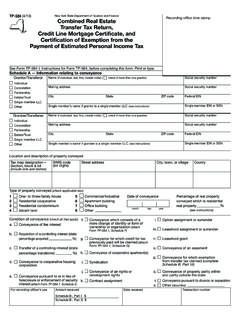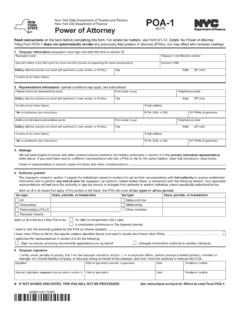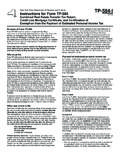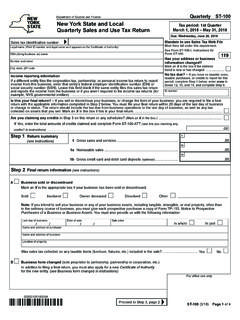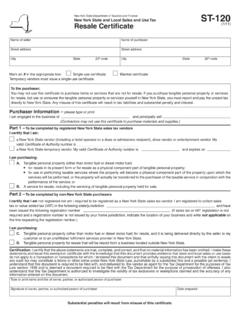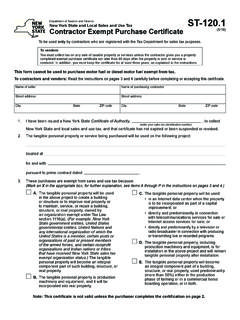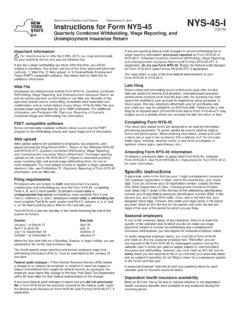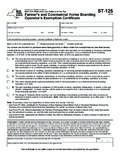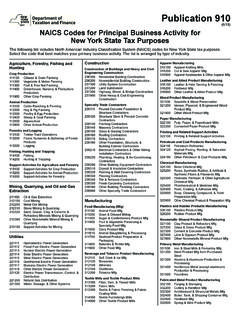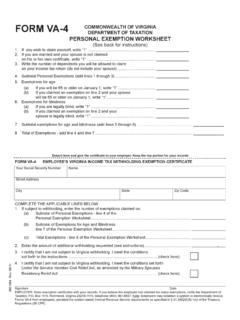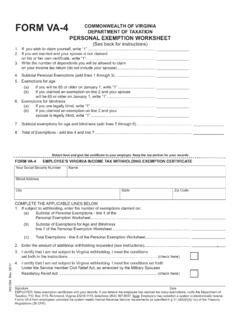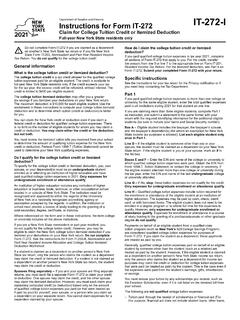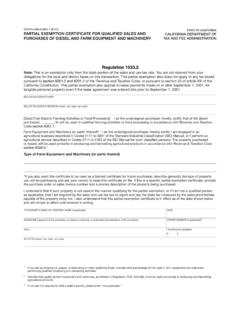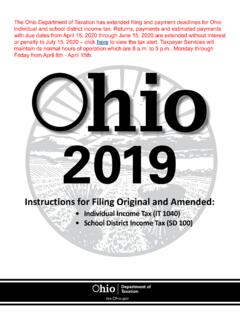Transcription of Department of Taxation and Finance Instructions for Form ...
1 Caution: For personal income tax purposes, NYS has decoupled from federal changes made to the Internal Revenue Code (IRC) after March 1, 2020. Therefore, certain individuals who claimed the federal credit may not be eligible for the NYS credit. Thresholds and amounts used in the calculation of this credit will be based on a recomputed federal adjusted gross income (FAGI). Line 19a on Forms IT-201 and IT-203 will be used, instead of line 19. If the amounts on your Form IT-201 or Form IT-203 lines 19 and 19a do not match, your New York credit must be calculated using the recomputed informationThe New York State child and dependent care credit is computed based on the amount of your New York adjusted gross income, the number of qualifying persons, and the amount of qualified expenses New York City child and dependent care credit can be as much as 75% of the New York State child and dependent care credit, depending on the amount of your recomputed qualifiesNew York State creditGenerally, if you qualify to claim the federal child and dependent care credit based on your recomputed FAGI, you can claim the New York State credit (whether you actually claim the federal credit or not).
2 If you did not file federal Form 2441 to claim the federal child and dependent care credit, you can still claim the New York State child and dependent care credit on Form IT-216 if all four of the following apply:1. Your filing status is Single, Head of household, Qualifying widow(er), or Married filing joint return. However, see special rule for Married persons filing separate federal and New York State returns The care was provided so you (and your spouse, if you were married) could work or look for work. However, if you did not find a job and have no earned income for the year, you cannot take the credit. If you or your spouse was a student or disabled, see the lines 6 and 7 Instructions on page Your child (or other qualifying person(s) for whom the care was provided) lived in the same home with you for more than half the The person who provided the care was not your spouse, the parent of your qualifying child under age 13, or a person whom you can claim as a dependent.
3 If your child provided the care, he or she must have been age 19 or older by December persons filing separate federal and New York State returns If your filing status is Married filing separate return and all of the following apply, you are considered unmarried for purposes of computing the child and dependent care credit: you lived apart from your spouse during the last six months of the tax year; and the qualifying person lived in your home more than half of the tax year; and you provided over half the cost of keeping up your you meet all the requirements to be treated as unmarried and meet items 2 through 4 above, you generally may claim the credit. If you do not meet all the requirements to be treated as unmarried, you generally cannot claim the persons filing joint federal returns, but required to file separate New York State returns If you and your spouse file jointly for federal purposes, but are required to file separate New York State returns because one spouse is a resident and the other spouse is either a nonresident or part-year resident, you may still claim the credit.
4 However, the credit must be claimed on the return of the spouse with the lower taxable income (computed without regard to the credit).Married persons not required to file a federal return If you and your spouse are not required to file a federal income tax return, the New York State child and dependent care credit is allowed only if you file a joint New York State tax return (Form IT 201 or IT 203).New York City credit To qualify for the New York City child and dependent care credit you must: qualify to claim the New York State child and dependent care credit; have paid qualified expenses for a qualifying person who was under age four on December 31; have recomputed federal adjusted gross income of $30,000 or less (see Note below); and have been a full-year or part-year resident of New York : For purposes of the New York City child and dependent care credit, recomputed FAGI means the amount entered on Form IT-201, line 19a, or on Form IT-203, line 19a, Federal amount column, less any interest included on line 2 of either of these forms that is for Build America Bonds as defined in IRC section persons filing joint federal returns, but required to calculate New York City taxes separately If you and your spouse file jointly for federal purposes, but are required to calculate your New York City taxes separately because one spouse is a resident and the other spouse is a nonresident or part-year resident, you may still be able to claim the credit.
5 In this instance, the credit must be applied against the spouse with the lower taxable income (computed without regard to the credit). However, if the spouse with the lower taxable income is a nonresident of New York City, neither you nor your spouse may claim the credit. Married persons not required to file a federal return If you and your spouse are not required to file a federal income tax return, the New York City child and dependent care credit is allowed only if you file a joint New York State income tax to claim the creditIn addition to meeting the above federal requirements, to claim the New York State or New York City child and dependent care credit you must: file a New York State income tax return, report the required information about the care provider on line 2 of Form IT-216, and complete Form who receive dependent care benefits from their employer must complete worksheet 1 Dependent care benefits.
6 Important termsA qualifying person is: A qualifying child under age 13 whom you can claim as a dependent (but see Special rule for children of divorced or separated parents or parents who live apart on page 2). If the child turned 13 during the year, the child is a qualifying person for the part of the year he or she was under age 13. Your spouse who is disabled and not able to care for himself or of Taxation and FinanceInstructions for Form IT-216 Claim for Child and Dependent Care CreditIT-216-IPage 2 of 8 IT-216-I (2021) Any person who is disabled and not able to care for himself or herself whom you can claim as a dependent (or could claim as a dependent except that the person had gross income of $4,300 or more or filed a joint return). Any person who is disabled and not able to care for himself or herself whom you could claim as a dependent except that you (or your spouse if filing a joint return) could be claimed as a dependent on someone else s you are divorced or separated, see Special rule for children of divorced or separated parents or parents who live apart the Instructions for worksheet 1, line 2, for a special rule that allows 2020 dependent care benefits reported on line 2 to be used in 2021 for a qualifying child under age find out who is a qualifying child and who is a dependent, see federal Publication 501, Dependents, Standard Deduction, and Filing.
7 To be a qualifying person, generally, the person must have lived with you for more than half of the tax rule for children of divorced or separated parents or parents who live apart Even if you cannot claim your child as a dependent, he or she is treated as your qualifying person if: The child was under age 13 or was physically or mentally not able to care for himself or herself; The child received over half of his or her support during the calendar year from one or both parents who are divorced or legally separated under a decree of divorce or separate maintenance, are separated under a written separation agreement, or lived apart at all times during the last 6 months of the calendar year; The child was in the custody of one or both parents for more than half the year; and You were the child s custodial , the custodial parent is the parent with whom the child lived for the greater number of nights in the tax year.
8 If the child was with each parent for an equal number of nights, the custodial parent is the parent with the higher FAGI. For details and an exception for a parent who works at night, see federal Publication , the noncustodial parent cannot treat the child as a qualifying person even if that parent is entitled to claim the child as a dependent under the special rules for a child of divorced or separated parents or parents who live find out when a noncustodial parent is entitled to claim the dependency exemption for a child, see federal Publication care benefits include amounts your employer paid directly to either you or your care provider for the care of your qualifying person(s) while you worked. These benefits also include the fair market value of care in a day-care facility provided or sponsored by your employer and pre-tax contributions you made under a dependent care flexible spending arrangement (FSA).
9 Your salary may have been reduced to pay for these benefits. If you received dependent care benefits as an employee, they should be shown in box 10 of your federal W-2 form(s).Benefits you received as a partner should be shown on your Schedule K-1 (federal Form 1065).If you receive dependent care benefits through your employer, you must complete worksheet expenses include amounts paid for household services and care of the qualifying person(s) while you worked or looked for work. Child support payments are not qualified expenses. Expenses reimbursed by a state social service agency are not qualified expenses. Also, expenses paid through a dependent care account are not qualified , if you worked or actively looked for work during only part of the period in which you incurred the expenses, you must compute your expenses for each day. However, there are special rules for temporary absences or part-time work.
10 See federal Publication 503, Child and Dependent Care Expenses, for more services are services needed to care for the qualifying person as well as to run the home while you worked or looked for work. They include, for example, the services of a cook, maid, babysitter, housekeeper, or cleaning person if the services were partly for the care of the qualifying person(s). Do not include services of a chauffeur or may also include your share of the employment taxes paid on wages for qualifying child and dependent care of the qualifying person includes expenses for the care of a qualifying person while you worked or looked for work only if their main purpose is for the person s well-being and protection. It does not include the cost of food, lodging, education, clothing, or may include the cost of care provided outside your home for your dependent under age 13 or any other qualifying person(s) who regularly spends at least 8 hours a day in your home.
